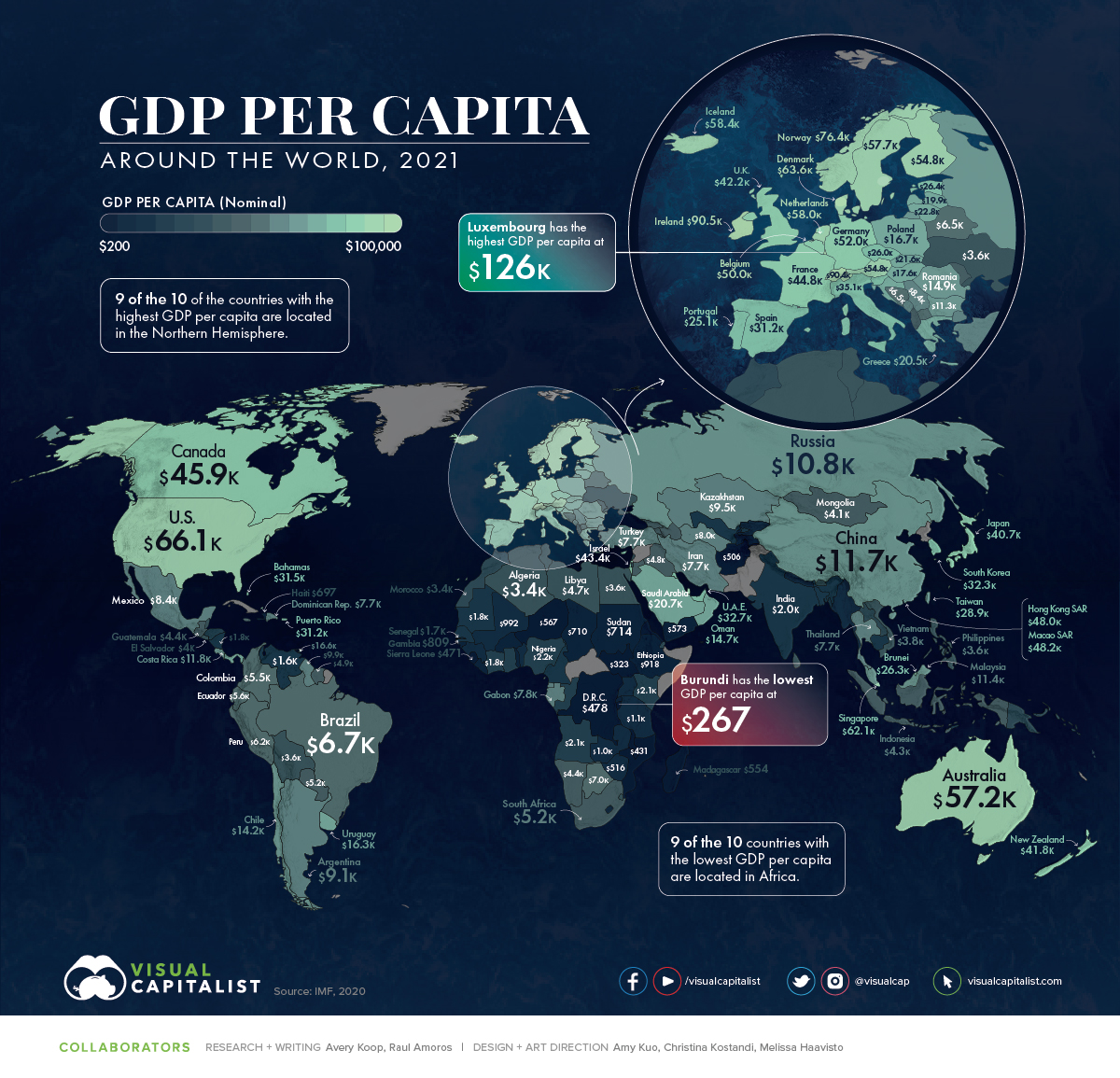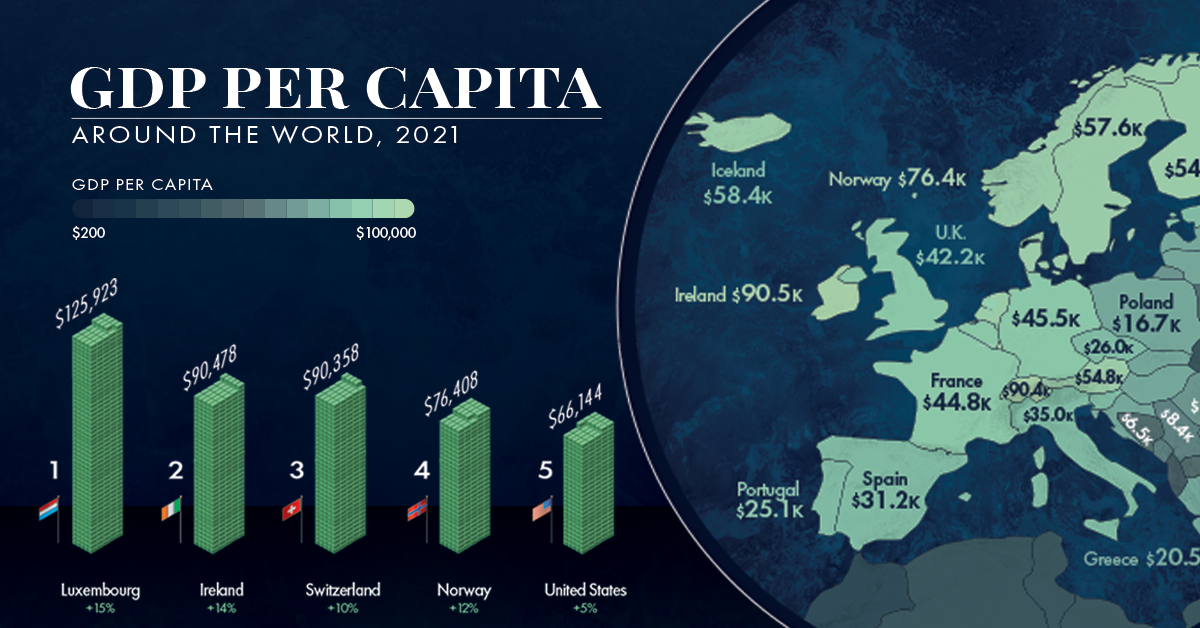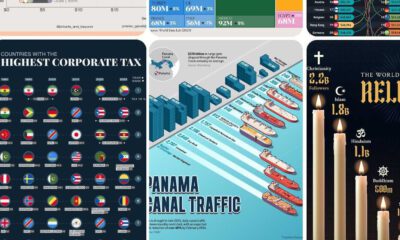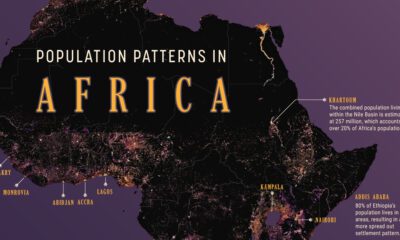Markets
Mapped: GDP per Capita Worldwide
View the full-resolution version of this infographic
Mapped: Visualizing GDP per Capita Worldwide
View the high-resolution of the infographic by clicking here.
GDP per capita has steadily risen globally over time, and in tandem, the standard of living worldwide has increased immensely.
This map using data from the IMF shows the GDP per capita (nominal) of nearly every country and territory in the world.
GDP per capita is one of the best measures of a country’s wealth as it provides an understanding of how each country’s citizens live on average, showing a representation of the quantity of goods and services created per person.
The Standard of Living Over Time
Looking at history, our standard of living has increased drastically. According to Our World in Data, from 1820 to 2018, the average global GDP per capita increased by almost 15x.
Literacy rates, access to vaccines, and basic education have also improved our quality of life, while things like child mortality rates and poverty have all decreased.
For example, in 1990, 1.9 billion people lived in extreme poverty, which was 36% of the world’s population at the time. Over the last 30 years, the number has been steadily decreasing — by 2030, an estimated 479 million people will be living in extreme poverty, which according to UN population estimates, will represent only 6% of the population.
That said, economic inequality between different regions is still prevalent. In fact, the richest country today (in terms of nominal GDP per capita), Luxembourg, is over 471x more wealthy than the poorest, Burundi.
Here’s a look at the 10 countries with the highest GDP per capita in 2021:
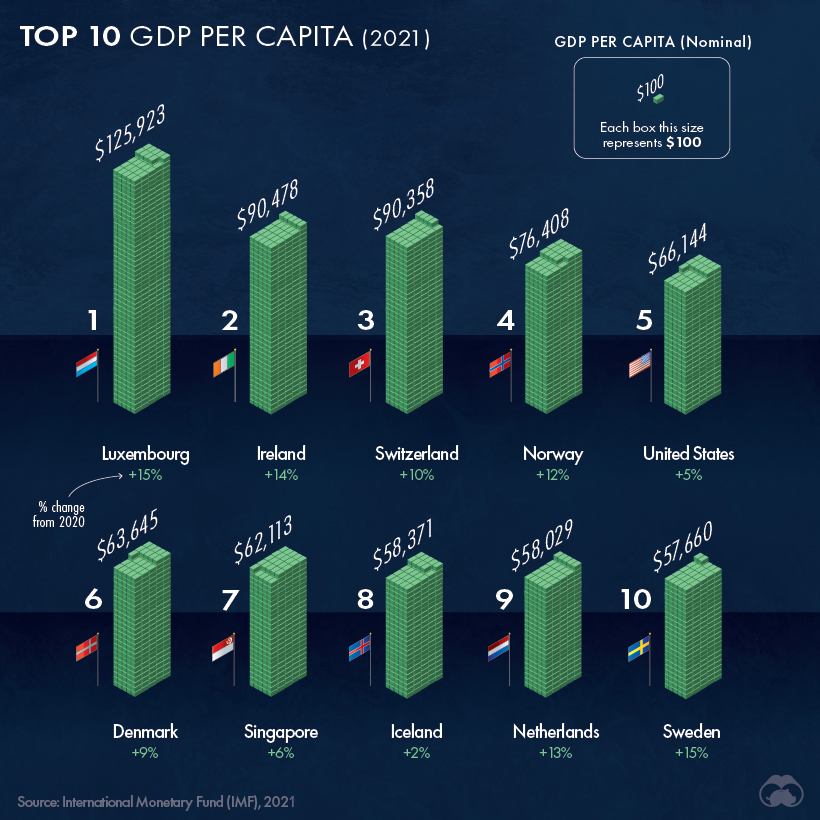
However, not all citizens in Luxembourg are extremely wealthy. In fact:
- 29% of people spend over 40% of their income on housing costs
- 31% would be at risk of falling into poverty if they had to forgo 3 months of income
The cost of living is expensive in Luxembourg — but the standard of living in terms of goods and services produced is the highest in the world. Additionally, only 4% of the population reports low life satisfaction.
Emerging Economies and Developing Countries
Although we have never lived in a more prosperous period, and poverty rates have been declining overall, this year global extreme poverty rose for the first time in over two decades.
About 120 million additional people are living in poverty as a result of the pandemic, with the total expected to rise to about 150 million by the end of 2021.
Many of the poorest countries in the world are also considered Least Developed Countries (LDCs) by the UN. In these countries, more than 75% of the population live below the poverty line.
Here’s a look at the 10 countries with the lowest GDP per capita:
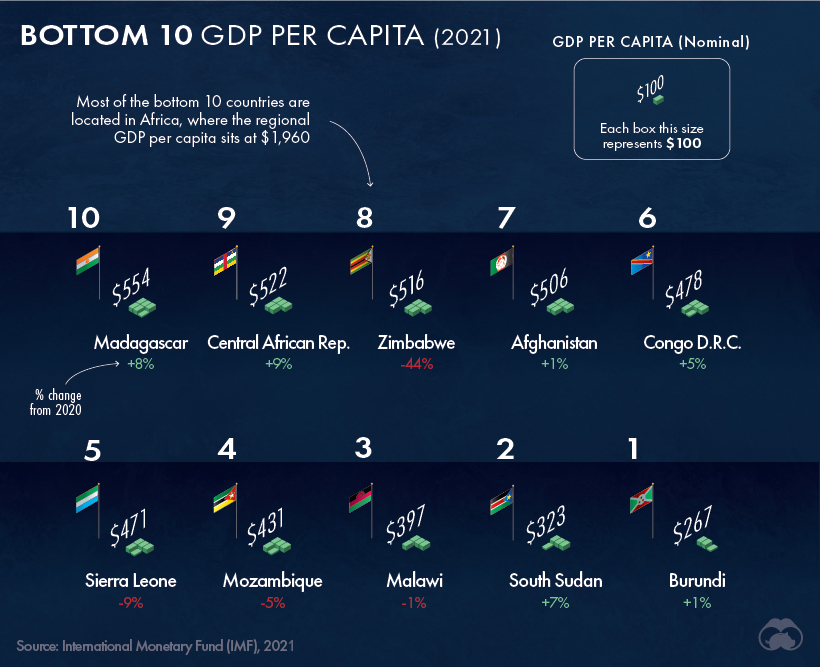
Life in these countries offers a stark contrast compared to the top 10. Here’s a glance at the quality of life in the poorest country, Burundi:
- 80% of the population works in agriculture
- 1 in 3 Burundians are in need of urgent humanitarian assistance
- Average households spend up to two-thirds of their income on food
However, many of the world’s poorest countries can also be classified as emerging markets with immense economic potential in the future.
In fact, China has seen the opportunity in emerging economies. Their confidence in these regions is best exemplified in the Belt and Road initiative which has funneled massive investments into infrastructure projects across multiple African countries.
Continually Raising the Bar
Prosperity is a very recent reality only characterizing the last couple hundred years. In pre-modern societies, the average person was living in conditions that would be considered extreme poverty by today’s standards.
Overall, the standard of living for everyone today is immensely improved compared to even recent history, and some countries will be experiencing rapid economic growth in the future.
GDP per Capita in 2021: Full Dataset
| Country | GDP per Capita (Nominal, 2021, USD) |
|---|---|
| 🇱🇺 Luxembourg | $125,923 |
| 🇮🇪 Ireland | $90,478 |
| 🇨🇭 Switzerland | $90,358 |
| 🇳🇴 Norway | $76,408 |
| 🇺🇸 United States | $66,144 |
| 🇩🇰 Denmark | $63,645 |
| 🇸🇬 Singapore | $62,113 |
| 🇮🇸 Iceland | $58,371 |
| 🇳🇱 Netherlands | $58,029 |
| 🇸🇪 Sweden | $57,660 |
| Australia | $57,211 |
| Qatar | $55,417 |
| Austria | $54,820 |
| Finland | $54,817 |
| Germany | $51,967 |
| Belgium | $50,051 |
| Macao SAR | $48,207 |
| Hong Kong SAR | $47,990 |
| Canada | $45,871 |
| France | $44,770 |
| San Marino | $44,676 |
| Israel | $43,439 |
| United Kingdom | $42,236 |
| New Zealand | $41,793 |
| Japan | $40,733 |
| Italy | $35,062 |
| United Arab Emirates | $32,686 |
| South Korea | $32,305 |
| Malta | $32,099 |
| The Bahamas | $31,532 |
| Puerto Rico | $31,207 |
| Spain | $31,178 |
| Europe | $31,022 |
| Cyprus | $29,686 |
| Taiwan | $28,890 |
| Slovenia | $28,734 |
| Estonia | $26,378 |
| Brunei | $26,274 |
| Czech Republic | $25,991 |
| Portugal | $25,097 |
| Bahrain | $23,710 |
| Kuwait | $23,138 |
| Lithuania | $22,752 |
| Aruba | $22,710 |
| Slovakia | $21,606 |
| Saudi Arabia | $20,742 |
| Greece | $20,521 |
| Latvia | $19,934 |
| Hungary | $17,645 |
| Barbados | $17,472 |
| Poland | $16,740 |
| Trinidad and Tobago | $16,622 |
| Saint Kitts and Nevis | $16,491 |
| Croatia | $16,402 |
| Uruguay | $16,297 |
| Romania | $14,916 |
| Antigua and Barbuda | $14,748 |
| Oman | $14,675 |
| Panama | $14,390 |
| Chile | $14,209 |
| Maldives | $14,194 |
| Palau | $13,180 |
| Seychelles | $12,648 |
| Costa Rica | $11,805 |
| China | $11,713 |
| Malaysia | $11,378 |
| Bulgaria | $11,349 |
| Russia | $10,793 |
| Saint Lucia | $10,636 |
| Grenada | $10,211 |
| Guyana | $9,913 |
| Nauru | $9,865 |
| Mauritius | $9,630 |
| Kazakhstan | $9,454 |
| Montenegro | $9,152 |
| Argentina | $9,095 |
| Turkmenistan | $8,874 |
| Serbia | $8,444 |
| Mexico | $8,403 |
| Dominica | $8,111 |
| Equatorial Guinea | $8,000 |
| Gabon | $7,785 |
| Dominican Republic | $7,740 |
| Thailand | $7,675 |
| Iran | $7,668 |
| Turkey | $7,659 |
| Saint Vincent and the Grenadines | $7,401 |
| Botswana | $7,036 |
| North Macedonia | $6,933 |
| Brazil | $6,728 |
| Bosnia and Herzegovina | $6,536 |
| Belarus | $6,513 |
| Peru | $6,229 |
| Jamaica | $5,643 |
| Ecuador | $5,589 |
| Colombia | $5,457 |
| South Africa | $5,236 |
| Paraguay | $5,207 |
| Albania | $5,161 |
| Tonga | $4,949 |
| Suriname | $4,921 |
| Fiji | $4,822 |
| Iraq | $4,767 |
| Kosovo | $4,753 |
| Libya | $4,733 |
| Georgia | $4,714 |
| Moldova | $4,527 |
| Armenia | $4,427 |
| Namibia | $4,412 |
| Azerbaijan | $4,404 |
| Guatemala | $4,385 |
| Jordan | $4,347 |
| Tuvalu | $4,296 |
| Indonesia | $4,287 |
| Mongolia | $4,139 |
| Marshall Islands | $4,092 |
| Samoa | $4,053 |
| El Salvador | $4,023 |
| Micronesia | $3,995 |
| Belize | $3,968 |
| Sri Lanka | $3,928 |
| Vietnam | $3,759 |
| Eswatini | $3,697 |
| Cabo Verde | $3,675 |
| Bolivia | $3,618 |
| Ukraine | $3,615 |
| Egypt | $3,606 |
| Philippines | $3,602 |
| North Africa | $3,560 |
| Algeria | $3,449 |
| Bhutan | $3,447 |
| Morocco | $3,409 |
| Tunisia | $3,380 |
| Djibouti | $3,275 |
| West Bank and Gaza | $3,060 |
| Vanuatu | $2,967 |
| Laos | $2,614 |
| Papua New Guinea | $2,596 |
| Honduras | $2,593 |
| Côte d'Ivoire | $2,571 |
| Solomon Islands | $2,501 |
| Ghana | $2,300 |
| Republic of Congo | $2,271 |
| Nigeria | $2,209 |
| São Tomé and Príncipe | $2,133 |
| Angola | $2,130 |
| Kenya | $2,122 |
| India | $2,031 |
| Bangladesh | $1,990 |
| Uzbekistan | $1,836 |
| Nicaragua | $1,828 |
| Kiribati | $1,817 |
| Mauritania | $1,782 |
| Cambodia | $1,680 |
| Cameroon | $1,657 |
| Senegal | $1,629 |
| Venezuela | $1,586 |
| Myanmar | $1,441 |
| Comoros | $1,431 |
| Benin | $1,400 |
| Timor-Leste | $1,273 |
| Kyrgyzstan | $1,270 |
| Nepal | $1,166 |
| Tanzania | $1,132 |
| Guinea | $1,067 |
| Lesotho | $1,018 |
| Zambia | $1,006 |
| Mali | $992 |
| Uganda | $971 |
| Ethiopia | $918 |
| Tajikistan | $851 |
| Burkina Faso | $851 |
| Guinea-Bissau | $844 |
| Rwanda | $820 |
| The Gambia | $809 |
| Togo | $759 |
| Sudan | $714 |
| Chad | $710 |
| Haiti | $698 |
| Liberia | $646 |
| Eritrea | $632 |
| Yemen | $573 |
| Niger | $567 |
| Madagascar | $554 |
| Central African Republic | $522 |
| Zimbabwe | $516 |
| Afghanistan | $506 |
| Democratic Republic of the Congo | $478 |
| Sierra Leone | $471 |
| Mozambique | $431 |
| Malawi | $397 |
| South Sudan | $323 |
| Burundi | $267 |
Editor’s note: Readers have rightly pointed out that Monaco is one of the world’s richest countries in GDP per capita (nominal) terms. This is true, but the IMF dataset excludes Monaco and lists it as “No data” each year. As a result, it is excluded from the visualization(s) above.
Markets
U.S. Debt Interest Payments Reach $1 Trillion
U.S. debt interest payments have surged past the $1 trillion dollar mark, amid high interest rates and an ever-expanding debt burden.

U.S. Debt Interest Payments Reach $1 Trillion
This was originally posted on our Voronoi app. Download the app for free on iOS or Android and discover incredible data-driven charts from a variety of trusted sources.
The cost of paying for America’s national debt crossed the $1 trillion dollar mark in 2023, driven by high interest rates and a record $34 trillion mountain of debt.
Over the last decade, U.S. debt interest payments have more than doubled amid vast government spending during the pandemic crisis. As debt payments continue to soar, the Congressional Budget Office (CBO) reported that debt servicing costs surpassed defense spending for the first time ever this year.
This graphic shows the sharp rise in U.S. debt payments, based on data from the Federal Reserve.
A $1 Trillion Interest Bill, and Growing
Below, we show how U.S. debt interest payments have risen at a faster pace than at another time in modern history:
| Date | Interest Payments | U.S. National Debt |
|---|---|---|
| 2023 | $1.0T | $34.0T |
| 2022 | $830B | $31.4T |
| 2021 | $612B | $29.6T |
| 2020 | $518B | $27.7T |
| 2019 | $564B | $23.2T |
| 2018 | $571B | $22.0T |
| 2017 | $493B | $20.5T |
| 2016 | $460B | $20.0T |
| 2015 | $435B | $18.9T |
| 2014 | $442B | $18.1T |
| 2013 | $425B | $17.2T |
| 2012 | $417B | $16.4T |
| 2011 | $433B | $15.2T |
| 2010 | $400B | $14.0T |
| 2009 | $354B | $12.3T |
| 2008 | $380B | $10.7T |
| 2007 | $414B | $9.2T |
| 2006 | $387B | $8.7T |
| 2005 | $355B | $8.2T |
| 2004 | $318B | $7.6T |
| 2003 | $294B | $7.0T |
| 2002 | $298B | $6.4T |
| 2001 | $318B | $5.9T |
| 2000 | $353B | $5.7T |
| 1999 | $353B | $5.8T |
| 1998 | $360B | $5.6T |
| 1997 | $368B | $5.5T |
| 1996 | $362B | $5.3T |
| 1995 | $357B | $5.0T |
| 1994 | $334B | $4.8T |
| 1993 | $311B | $4.5T |
| 1992 | $306B | $4.2T |
| 1991 | $308B | $3.8T |
| 1990 | $298B | $3.4T |
| 1989 | $275B | $3.0T |
| 1988 | $254B | $2.7T |
| 1987 | $240B | $2.4T |
| 1986 | $225B | $2.2T |
| 1985 | $219B | $1.9T |
| 1984 | $205B | $1.7T |
| 1983 | $176B | $1.4T |
| 1982 | $157B | $1.2T |
| 1981 | $142B | $1.0T |
| 1980 | $113B | $930.2B |
| 1979 | $96B | $845.1B |
| 1978 | $84B | $789.2B |
| 1977 | $69B | $718.9B |
| 1976 | $61B | $653.5B |
| 1975 | $55B | $576.6B |
| 1974 | $50B | $492.7B |
| 1973 | $45B | $469.1B |
| 1972 | $39B | $448.5B |
| 1971 | $36B | $424.1B |
| 1970 | $35B | $389.2B |
| 1969 | $30B | $368.2B |
| 1968 | $25B | $358.0B |
| 1967 | $23B | $344.7B |
| 1966 | $21B | $329.3B |
Interest payments represent seasonally adjusted annual rate at the end of Q4.
At current rates, the U.S. national debt is growing by a remarkable $1 trillion about every 100 days, equal to roughly $3.6 trillion per year.
As the national debt has ballooned, debt payments even exceeded Medicaid outlays in 2023—one of the government’s largest expenditures. On average, the U.S. spent more than $2 billion per day on interest costs last year. Going further, the U.S. government is projected to spend a historic $12.4 trillion on interest payments over the next decade, averaging about $37,100 per American.
Exacerbating matters is that the U.S. is running a steep deficit, which stood at $1.1 trillion for the first six months of fiscal 2024. This has accelerated due to the 43% increase in debt servicing costs along with a $31 billion dollar increase in defense spending from a year earlier. Additionally, a $30 billion increase in funding for the Federal Deposit Insurance Corporation in light of the regional banking crisis last year was a major contributor to the deficit increase.
Overall, the CBO forecasts that roughly 75% of the federal deficit’s increase will be due to interest costs by 2034.
-

 Real Estate2 weeks ago
Real Estate2 weeks agoVisualizing America’s Shortage of Affordable Homes
-

 Technology1 week ago
Technology1 week agoRanked: Semiconductor Companies by Industry Revenue Share
-

 Money2 weeks ago
Money2 weeks agoWhich States Have the Highest Minimum Wage in America?
-

 Real Estate2 weeks ago
Real Estate2 weeks agoRanked: The Most Valuable Housing Markets in America
-

 Business2 weeks ago
Business2 weeks agoCharted: Big Four Market Share by S&P 500 Audits
-

 AI2 weeks ago
AI2 weeks agoThe Stock Performance of U.S. Chipmakers So Far in 2024
-

 Misc2 weeks ago
Misc2 weeks agoAlmost Every EV Stock is Down After Q1 2024
-

 Money2 weeks ago
Money2 weeks agoWhere Does One U.S. Tax Dollar Go?

